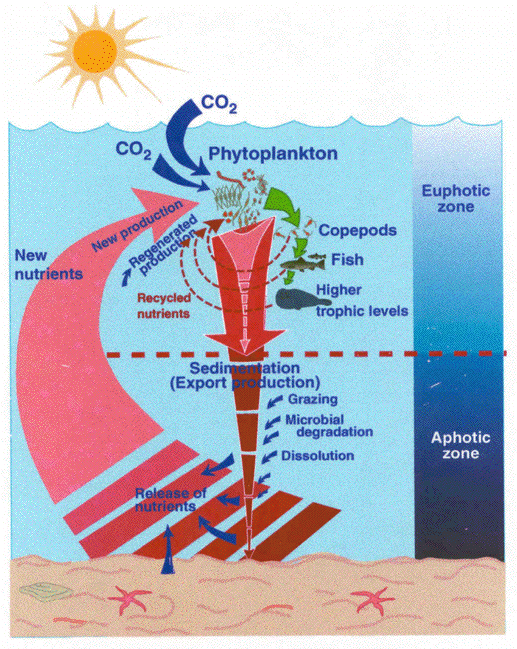


 |  |  | 8.4 Nutrient supply, primary production, retention and vertical export |
Increased supply of nutrients to the euphotic zone gives rise to increased production of algae which sooner or later sink to deeper water and the sediment, resulting in increased sediment-water exchange rates, at times in mass mortality of macrofauna and fish eggs [399][322] and finally in anoxia [398][181]. During the last decades wide-spread occurrence of low oxygen concentrations or anoxia in bottom waters, decreased catches of fish and blooms of toxic algae threatening aquaculture as well as stocks of wild animals have been reported with increasing frequency [399]. These changes seem to be caused by increased inputs of nutrients to aquatic areas from sewage, agricultural run-off and atmospheric fall-out, giving rise to various degrees of eutrophication of fresh-water as well as marine, coastal environments (e.g. Wulff et al., [501]).
Figure below shows the principle processes of atmospheric CO2 uptake and release, primary production, suspended biomass and vertical export to the bottom. Seawater takes up CO2 from the atmosphere that is either taken up by phytoplankton or released again to the atmosphere. The phytoplankton uptake of CO2 is caused by primary production and first and foremost dependent on photosynthetic active radiation and nutrients. In addition it is influenced by the residence time of phytoplankton in the euphotic layer (determined by vertical mixing and stratification). Phytoplankton accumulates in the upper layers if grazing and degradation rates are lower than primary production, i.e. a bloom takes shape. A part of the suspended biomass consistent on phytoplankton cells and detritus from grazing and degradation will sink into the aphotic zone and further to the bottom. The export of biogenic matter to the bottom is a complex function of the total amount of suspended matter, the sinking velocity of the sinking particles and the degradation impact of the pelagic heterotrophs. For example, low suspended biomass, low pelagic degradation and high sinking rates give result in a similar sedimentation rate at depth than high suspended biomass, high pelagic degradation and low sinking rates. Degradation of organic matter in the water column or the sediment results in nutrients that sooner or later can be taken up by phytoplankton.

If the limiting nutrient is nitrogen the net primary production depends on the allochthonous nutrient nitrate while the remaining primary production is based upon the autochthonous nutrient ammonium that derives from internal recycling by heterotrophic organisms. The basic principle to use nitrogen species to determine how much of the total primary production comprises new production (in case nitrogen is the limiting element) is difficult to apply in shallow water where the cycle of nutrients is rapid and where particulate nitrogen supplied to the bottom can be recycled to nitrate that is available for primary production. In this case nitrate is not new, but regenerated. Thus some of the nitrate is not `new' and does not comply with the basic assumption of new production. In countless eutrophicated regions ammonium and urea are supplied as allochthonous nutrients. Also in this case the traditional method to distinguish new from regenerated production is not possible because some of the per definition autochthonous nutrients are allochthonous. New production is thus impossible to measure in eutrophicated waters.
The state of an ecosystem during a transient bloom is basically characterised by export food chains with high vertical export. The amount of regenerated production increases, as the planktonic system develops and becomes more complex during the post bloom phase. Sedimentation of organic material is low and the ecosystem is characterised by retention food chains. In the non-eutrophicated coastal zone export chains are based upon new production and represent episodic events on the background of a continuous, seasonally variable regenerated production based on the recycled nutrients from retention chains. If eutrophication continues, i.e. nutrients are supplied in a steady manner, a new steady state with a mixture of export and retention food chains will develop.
In conclusion, an estimate of new/net/harvestable production as a consequence of eutrophication in coastal zones is difficult to measure, among other reason because our terminology and measuring techniques are inadequate.
 |  |  | 8.4 Nutrient supply, primary production, retention and vertical export |